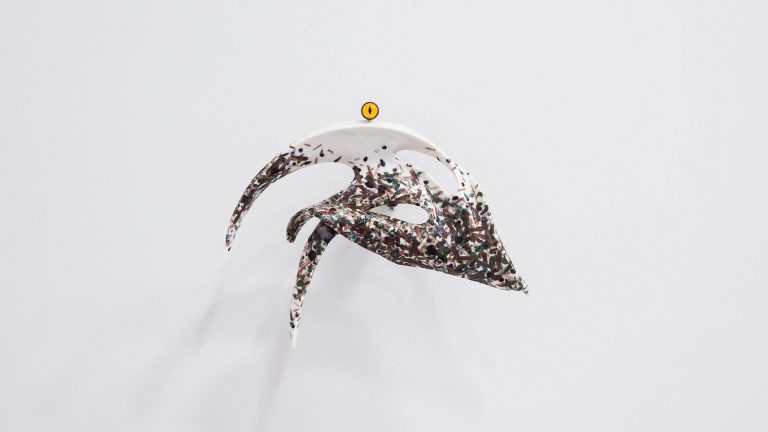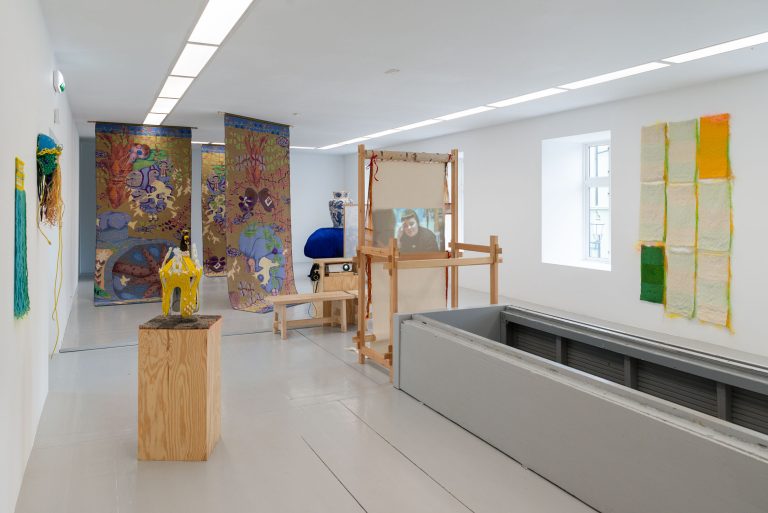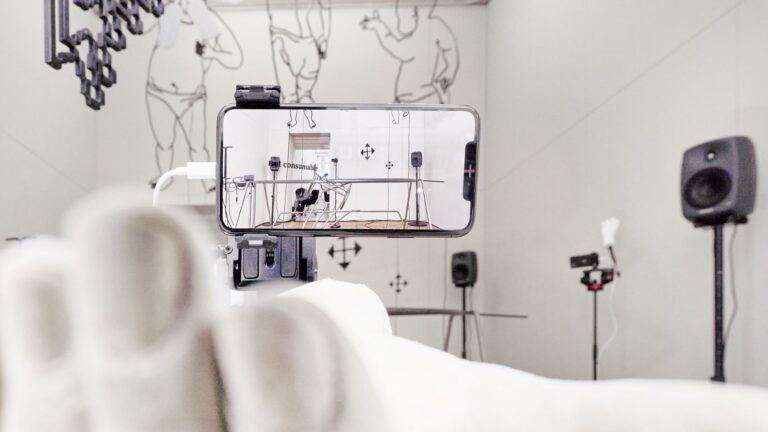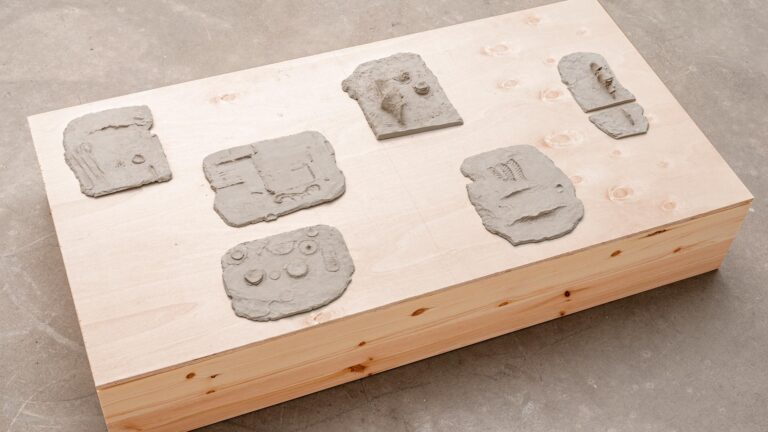On my wall at home, I have a work by Kristen Keegan. It is a kind of book, but it is made from sheets of waxed cotton, not paper. Each page has its own colours, broad stripes that border or flow into each other. It is made from studio scraps, cut-offs from large paintings. The way I have installed it on my living room wall makes it resemble a calendar, even though it exclusively displays colours. The spine is horizontal, the book is spread open and fixed to the wall with a thin nail. When I turn the pages, a new colour composition comes into view. The images opening toward the room almost always look like landscapes.
When my father visited me not long ago, he asked about the artwork. What does it symbolize, he said, or something like that. On this day the book was opened to a spread with a deep green that bordered softly towards an almost black blue. A pale pink surface shone in from the opposite side, streaked with barely visible toffee brown. I understood what he meant; I just didn’t quite know how to respond. I said: Do you remember that autumn evening when me and you and mum walked across the heath to Melstokkevatnet, much later in the day than we usually do, at dusk? When in the end we had to use our phones as torches, to see where the trail ended, and the pine thicket began?
*
Keegan shows me the pieces she has prepared for The mutual work, paintings on cotton and silk, spread throughout her studio. The textiles are dyed, stained, or brushed with natural colour. On certain small, stretched cotton canvases, Keegan allows the polychrome potential of one and the same dye plant to be seen: from the edges of a yellow rectangle, painted with bayberry on fustic, oozes a halo of moss green and purple. Several of the works feature the coloured stripes that have become Keegan’s signature, now with more air – or maybe light? – between them than before. These paintings are less landscape-like than the work I have hanging at home, but they still remind me of phenomena from nature. When the silk moves, there seems to be something watery about it, reminiscent of how light is reflected off the sea. The blurred cotton monochromes make me think of dawn, twilight.
*
I am not always able to identify what it is about her paintings that affects me. Sometimes there seems to be a simple explanation. A yellow rectangle, softly delineated: the bodily memory of sun through a window, as it hits the interior, the face. A horizontal line where dark green mixes with an almost black blue: the silhouettes of my father and my mother on the darkening heath. But, for example, a large painting with mainly transverse stripes, where two vertical strokes create a grid pattern – what is it about these two strokes, their thin red colour, how they cross the transverse lines of the image, swelling at the points of intersection? Why does it feel like my heart rate rises when I look at it? What do the two strokes remind me of – blood diluted in water? Watered-out berry juice? Red marks on skin? Afterimages, stinging behind the eyelids? A gleam, a smouldering, an expansion.
*
How colours affect us still seems to have a certain mystery attached to it, despite all the colour theory that exists. Perhaps this particularly applies to colour presented nonfiguratively, colour that we might be tempted to describe as “just colour”, even if “just colour” is an impossibility. In Maggie Nelson’s book Bluets, a collection of propositions on blue (and on loss, grief, love), with a form inspired by Wittgenstein’s Remarks on Colour, Nelson writes: Admit that you have stood in front of a little pile of powdered ultramarine pigment in a glass cup at a museum and felt a stinging desire. But to do what? Liberate it? Purchase it? Ingest it?
*
During the past year, Keegan has moved away from using synthetic pigment entirely. Now she paints, stains, and dyes her textiles with natural colours, mainly from plants. These colours are more unpredictable than the synthetic ones. You have to spend time getting to know each new material, learn what treatment it needs to produce the colour you want. Some of the colours Keegan uses come from the dark, saturated material found at the very core of various types of wood, the heartwood. Others from bark, dried flowers. The red colour in the grid painting I get hung up on does not come from a plant, but from a type of lice that lives on cacti. Cochineal lice, sun-dried and crushed and boiled to make colour. The colour they give is called carmine red. The body of the lice (when alive) produces an acid to keep predators away, which is how the colour first occurs. Carmine is used, amongst other things, in food and lipstick. People have extracted red dye from cochineal lice since 700 BC. One could write a four-page text just about carmine.
*
In Buddhist philosophy, they talk about emptiness, says Keegan. But not as a void. More like: Any given thing does not contain a separate self. Nothing, not even colour, can be distinguished as an autonomous substance. Colour is saturated with context – with the material it stems from, with its different histories of use, with the material it becomes part of when one paints with it, with the space the canvases are hung in, with you when you see it.
*
It seems impossible to separate the senses from one another completely. It seems impossible to separate vision from memory, from the smell of marsh and heather and pine, from the sound of footsteps muffled against the forest floor, from the sensation of sinking one’s own fleshy body into cold water.
*
She says, I’ve had to order new tools, pointing to a bouquet of discarded brushes in a jar. Those ones discoloured the paint. At first, I didn’t understand what was happening, why the colour changed as I was painting. But that was because those brushes over there have copper ferrules, and the metal affects the dye. Substances affect each other, this is something she experiences all the time in her work with colour. And it is probably no different for us humans, we are also affected by the substances we come into contact with. She tells me about something she learned at Atelier Shimura, a workshop in Kyoto she visited this summer: that there are those who think of the colour of a given plant as an amulet. That each plant colour has special properties, which rub off on the person who wears it. I tell her about something I recently read at a cultural history museum in an exhibition about the use of text in ancient Egypt: how, at the time, written signs were believed to have a magical power, which could be accessed through physical contact. If, for example, one poured water over a sign carved into a block of stone, the water would be charged with the magic of that sign. And if you then drank the water, you yourself would be filled with that power.
*
Or as Thomas A Clark (one of the poets Keegan likes) puts it, in one of his poems:
water that flows
through watercress
receives the qualities
of watercress
Text by Cecilie Almberg Størkson
Kristen Keegan (b. 1988, Canada) is based in Bergen with a studio at Kunstnerverksteder CS55. She explores the function of abstract images to encourage wide attention. Engaging materials in a conversational approach, her works are a close study of colour, perception, and gesture. These exploratory methods result in projects of varied formats, including paintings, textile composites and book editions. Keegan completed her master’s in fine art at UiB’s Faculty of Art, Music and Design in 2019 and has since exhibited at venues throughout Scandinavia, including Entrée, Kunsthuset Kabuso, LNM, Konstepidemin, Årsutstillingen, Høstutstillingen and Hordaland Kunstsenter. She has participated in residencies such as Mustarinda in Finland and Messen in Øystese. Her work is held in public collections including the University of Bergen and KODE museum. Next year she is developing a new project in collaboration with Trykkeriet.




























